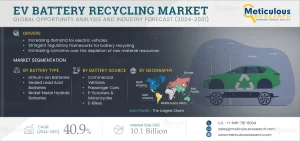The EV Battery Recycling Market was valued at $0.72 billion in 2023. This market is expected to reach $10.1 billion by 2031 from an estimated $0.91 billion in 2024, at a CAGR of 40.9% during the forecast period 2024-2031.
As the world accelerates towards a greener future, the emphasis on battery recycling has gained significant traction. Battery recycling is crucial for minimizing environmental waste, conserving natural resources, and mitigating the dangers of hazardous materials in landfills. This practice is especially important in the context of electric vehicle (EV) batteries, which contain a mix of heavy metals and toxic chemicals. In this blog, we delve into the intricacies of EV battery recycling and the various processes involved, highlighting the significance of these innovations in our journey towards sustainability.

Download Sample Report Here @ https://www.meticulousresearch.com/download-sample-report/cp_id=5483
Understanding EV Battery Recycling
EV battery recycling involves reusing and reprocessing used batteries to minimize waste. With components that can lead to water and soil contamination if disposed of improperly, EV batteries such as lithium-ion, sealed lead acid, and nickel-metal hydride require specialized recycling methods. These batteries harbor valuable metals—like lithium, cobalt, nickel, aluminum, iron, graphite, and manganese—that are essential for various industries. Thus, the recycling process must be efficient and environmentally friendly.
Direct Recycling: A Sustainable Approach
One of the most promising methods in EV battery recycling is direct recycling. This process entails shredding the battery to separate its components without altering the chemical structure of the active materials. By maintaining the integrity of the lithium-ion battery cathode, direct recycling allows for a cost-effective secondary use of materials. This method employs physical processes, such as gravity separation, to extract the active material powder from the shredded cells.
Advantages of Direct Recycling
- Cost-Effective: This method significantly reduces costs associated with chemical processing.
- Environmental Impact: It minimizes immediate environmental concerns by limiting the breakdown of materials.
Pyrometallurgical Recycling: Harnessing Heat
Pyrometallurgy is another critical method in the EV battery recycling landscape. This heat-intensive process leverages high temperatures to evaporate organic materials and facilitate reactions in the cathode and anode, thereby making lithium soluble in water. Subsequently, the materials are recycled from this aqueous solution. For instance, lithium-ion batteries undergo calcination at temperatures exceeding 700 °C, transforming lithium metal oxides into lithium carbonate (Li₂CO₃) and various metal oxides.
Advantages of Pyrometallurgical Recycling
- High Recovery Rates: This method boasts excellent metal recovery rates, making it efficient for processing various battery types.
- Versatility: Pyrometallurgy can handle a range of battery chemistries, which broadens its applicability.
Hydrometallurgical Recycling: Water-Based Solutions
Hydrometallurgy is another pivotal process in battery recycling, involving the extraction of metals from ores through water-based solutions. This technique encompasses various stages, including leaching, purification, and selective precipitation or electrowinning. Historically significant, hydrometallurgy has evolved to recover over 70 metallic elements, making it a cornerstone in modern recycling efforts.
Advantages of Hydrometallurgical Recycling
- Lower Environmental Impact: Compared to traditional mining, hydrometallurgy significantly reduces ecological damage.
- Selective Extraction: This method allows for the targeted recovery of specific metals, enhancing efficiency.
Get Insightful Data On Regions, Market Segments, Customer Landscape, And Top Companies (Charts, Tables, Figures And More) :- https://www.meticulousresearch.com/request-sample-report/cp_id=5483
Hybrid Recycling Processes: The Best of Both Worlds
Emerging hybrid recycling approaches are gaining attention for their effectiveness in maximizing material recovery. These processes often combine elements of pyrometallurgical and hydrometallurgical techniques to optimize the recycling of complex materials. For instance, the pyro-hydro hybrid process melds the heat-driven pyrometallurgy with the selective chemical processes of hydrometallurgy.
Benefits of Hybrid Recycling
- Material Preparation: Direct and mechanical processes, such as shredding, can be coupled with hydrometallurgical methods to prepare materials for efficient extraction.
- Comprehensive Solutions: The combination of hydro-mechanical and pyrometallurgical techniques can effectively manage intricate waste streams.
Insights into the EV Battery Recycling Market
The EV Battery Recycling Market is poised for significant growth, with projections indicating a potential value of $10.1 billion by 2031, at a remarkable CAGR of 40.9% from 2024 to 2031. Several factors are propelling this growth:
- Increasing EV Demand: As electric vehicles gain popularity, the need for sustainable recycling methods is more pressing than ever.
- Stringent Regulations: Regulatory frameworks governing battery recycling are becoming increasingly rigorous, pushing manufacturers to adopt sustainable practices.
- Resource Depletion Concerns: As raw materials dwindle, efficient recycling becomes essential for ensuring a steady supply of critical metals.
Additionally, government incentives for battery recycling and ongoing innovations in recycling technologies are anticipated to drive market expansion. Emerging economies are also investing heavily in battery recycling infrastructure, paving the way for a sustainable future.
Scope of the Report:-
By Battery Type
- Lithium-ion Batteries
- Sealed Lead Acid Batteries
- Nickel-metal Hydride Batteries
- Other Batteries
By Battery Source
- Commercial Vehicles
- Heavy Commercial Vehicles
- Light Commercial Vehicles
- Passenger Cars
- Battery Electric Vehicles
- Pure Hybrid Electric Vehicles
- Plug-in Hybrid Electric Vehicles
- E-scooters & Motorcycles
- E-bikes
By Recycling Process
- Direct Physical Recycling Process
- Pyrometallurgical Process
- Hydrometallurgical Process
- Other Recycling Processes
By Business Model
- Contractual Recycling Services
- Direct-to-Market Recycled Materials
By Material
- Graphite
- Nickel
- Cobalt
- Copper
- Manganese
- Lithium
- Aluminum
- Iron
- Plastics
- Other Materials
Immediate Delivery Available | BUY THIS RESEARCH REPORT (Insights, Charts, Tables, Figures and More) –https://www.meticulousresearch.com/Checkout/45013298
Key Players in the Market
Prominent industry players, including Glencore plc (Switzerland), Fortum Corporation (Finland), Umicore NV (Belgium), Li-Cycle Holdings Corp. (Canada), and Lithion Recycling Inc. (Canada), are actively contributing to the growth of EV battery recycling plants across diverse regions.
Contact Us:
Meticulous Market Research Pvt. Ltd.
1267 Willis St, Ste 200 Redding,California, 96001, U.S.
USA: +1-646-781-8004
Europe: +44-203-868-8738
APAC: +91 744-7780008
Email– sales@meticulousresearch.com
Visit Our Website: https://www.meticulousresearch.com/
Connect with us on LinkedIn- https://www.linkedin.com/company/meticulous-research
Meticulousblog.org | Top Market Research Reports Blog – https://meticulousblog.org/






